|
|
Post by templeton on Sept 19, 2016 17:00:00 GMT -5
Hoping these pics load... The selection process - leave these purple stemed ones when thinning 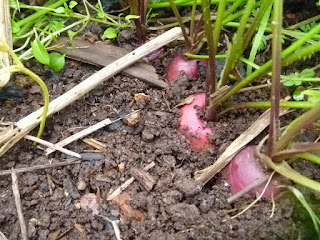 The first handful - success! 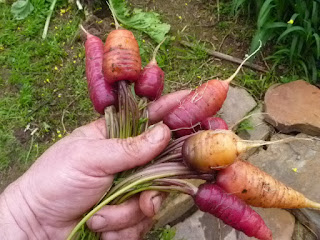 Can't believe the luminous magentas, and the shortness 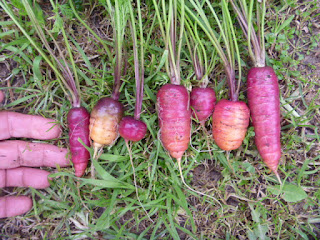 The new projects Purple Paris  Red Wedge 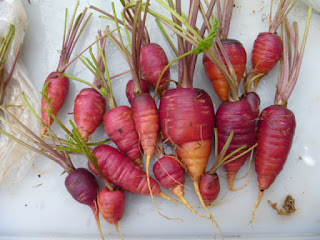 Magenta Candles 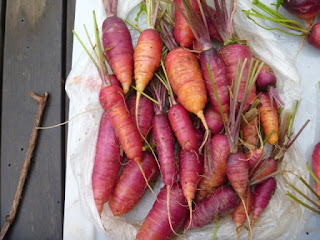 and maybe a Paris White, if they go in the right direction  love this diversity... 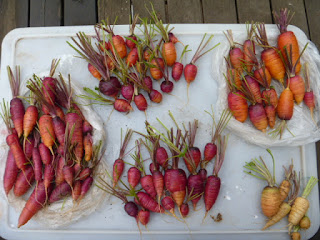 T ...hope this works... |
|
|
|
Post by shoshannah on Sept 19, 2016 17:22:24 GMT -5
I can see all your lovely carrots.
|
|
|
|
Post by ferdzy on Sept 20, 2016 14:19:16 GMT -5
Yes, I can see them too (this time). They look delightful!
|
|
|
|
Post by prairiegarden on Sept 20, 2016 16:06:38 GMT -5
Carrots look great! Have you sacrificed any to see what you think about the flavour?
|
|
|
|
Post by richardw on Sept 20, 2016 16:35:13 GMT -5
Look good alright. So whats the plans now with each of them lots
|
|
|
|
Post by templeton on Sept 26, 2016 4:51:58 GMT -5
Thanks for the kind comments. I uploaded the pics tp my blog then reposted the links... @prariegarden, I've eaten a couple of the plainer coloured ones -perhaps im not a carrot aficianado, they just tasted nicely carroty to me, but Ms Templeton thought they were outstanding
And apologies for late reply, I'm out bush with my students for 6 days, with poor coverage. Lying in my tent between rain fronts...
t
|
|
|
|
Post by templeton on Sept 26, 2016 5:06:34 GMT -5
Look good alright. So whats the plans now with each of them lots Richard, i planted the selections a bove in oposite corners of my small backyard garden, tucked away at the ends of beds, hoping that most of the crossing will take place within groups rather than between groups...last time I paid much attention to pollinators on these they were crawling with tiny flies and beetles crawling over the umbels, so i suspect much of the pollination is quite local. I'll sow next generation seed from these batches next autumn, grow out over austral winter 2017, reselect next spring, 2017 plant out summer 17-18, and hopefully offer grexelections austral autumn 2018 hmmm, when i put it like that, seems a bit daunting.. While im possibly encourging early bolting by single year seeding, i am aiming for quick turnover, small carots, at some stage i would love to cross back to some really deep purple carrots, but that might be. a few seasobs off. t |
|
|
|
Post by ilex on Sept 28, 2016 10:43:17 GMT -5
Annual vs biannual is just a matter of how much cold is required before bolting. By planting late summer/fall you just don't know if they are annuals or not. I don't think you are selecting for that trait.
If you plant late winter or fall, annuals will bolt. If I remember well, it's mostly a single gene involved. With enough population it should be easy to select for biannuals if that is what you want. Obviously if you start with some biannuals. As most varieties are like that, you should be ok.
|
|
|
|
Post by richardw on Sept 28, 2016 14:08:58 GMT -5
I'm sure many of the larger seed producers dont do enough selecting for bolting resistance. A lot of home gardeners like to have early spring carrots, but because they plant early there tends to be a high rate of bolters from commercially bought seed. About 10 years ago i started sowing my Benhorn carrot line under a plastic hoophouse around the shortest day with the idea to expose the bolting trait, in those first few seasons i would have pulled 30% of the crop by the end of autumn. That trait has not shown itself in the last two years with zero bolters. That got me thinking, could that boundary be pushed back further by sowing a month earlier- a month or two before the shortest day? Could a carrot be selected to flower at three years old? one could ask ' what would be the advantage of that?', the answer to that is then you could have a carrot that sees out the 'spring hunger gap"....just a thought
|
|
|
|
Post by templeton on Oct 12, 2016 4:15:51 GMT -5
Here's the second batch of short fat coloured carrots, pulled today. the luminescence is pretty exciting. Taste is ok too. 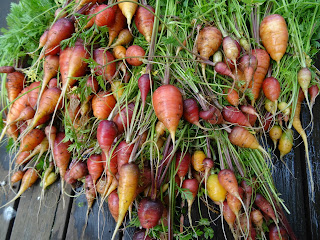 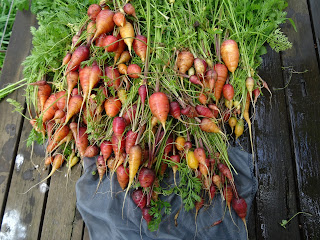 T |
|
|
|
Post by rowan on Oct 12, 2016 4:35:02 GMT -5
Looking great so far
|
|
|
|
Post by steve1 on Oct 12, 2016 5:28:46 GMT -5
templeton - I'm sure you know but If you find any carrots you particularly like the taste of you can replant the leafy tops for seed... Looking great!
|
|
|
|
Post by richardw on Oct 12, 2016 12:56:22 GMT -5
That was mentioned a while back on here about selecting for taste, so i did that last summer with my Benhorn, gave up after about 20 carrots as i couldn't pick any difference
|
|
|
|
Post by richardw on Oct 12, 2016 12:59:58 GMT -5
templeton How will you select them, will you choose just one colour or will ya want to keep mixing the range of shades of colours
|
|
|
|
Post by templeton on Oct 12, 2016 16:01:13 GMT -5
templeton How will you select them, will you choose just one colour or will ya want to keep mixing the range of shades of colours Richard, I've sorted the previous batch, from a different seed lot, into 3 or 4 projects. 2 of those are replicated in this batch, so will get additional side-by-side plantings of these new ones to get into the mix. While most of the characteristics are gradational, there seem to be a few cohorts i can pick out. There seems to be a clear cohort of fast growing, medium coloured short wedge-shaped roots, I'm selecting these based on their robustness and ability to grow fast over my relatively mild winters. I'm hoping this isn't just hybrid vigor. This is Red Wedge grex. There were a couple of splitters that I've rogued out. Anything that is short and round-ended rather than tapering, with nice colour is going into a separate growout, tentatively named Purple Balls grex (no snickering, Steev). Some of these have a slight pointy tap root, rather than pure blunt ends, and some also seem to have pale cores - there are a couple that are pearly- pink/mauve, probably purple skin over white centres. Magenta Candles grex got selected from the first batch - long, straight-sided, with purple. there weren't any in this second batch. I think the differences in root shape between batches is the different parental strategies - I didn't keep records  , but for this second batch I seem to recall planting colours and short round ones together, and only selecting seed heads from the short round parents...maybe... Anyway, doesn't matter much, I'm happy with the results so far, but the purple is really only skin deep - will work on the next generation for deeper colours. This grexing approach to breeding is certainly interesting, different mindset to intentional directed crosses... And the replants are doing well. As are the short fat parsnip replants. As an aside, the inability to link my picasa pics to here has got me re-posting to my much neglected blog - write a quick post, upload pics to there, then repost pic links here...shove that in your pipe and smoke it, mr google  T |
|